A Qualitative Study of the Critical Conditions for the Initiation of Mine Waste Debris Flows
Abstract
:1. Introduction
2. Experimental Methods
2.1. Experimental Setup
2.2. The Characteristics of the Mine Waste
2.3. Design of the Simulation Experiments
3. Experiment Results and Discussion
3.1. Analysis of the Experimental Results of Hydraulic Debris Flows
3.2. Analysis of the Experimental Results for Geotechnical Debris Flows
3.3. Analysis of the Critical Conditions for Debris Flow Initiation
4. Conclusions
Author Contributions
Funding
Conflicts of Interest
References
- Iverson, R.M. The physics of debris flows. Rev. Geophys. 1997, 35, 245–296. [Google Scholar] [CrossRef] [Green Version]
- Hungr, O.; Leroueil, S.; Picarelli, L. The Varnes classification of landslide types, an update. Landslides 2014, 11, 167–194. [Google Scholar] [CrossRef]
- Cui, Y.F.; Zhou, X.J.; Guo, C.X. Experimental study on the moving characteristics of fine grains in wide grading unconsolidated soil under heavy rainfall. J. Mt. Sci. 2017, 14, 417–431. [Google Scholar] [CrossRef]
- Kang, S.H.; Lee, S.R. Debris flow susceptibility assessment based on an empirical approach in the central region of South Korea. Geomorphology 2018, 308, 1–12. [Google Scholar] [CrossRef]
- Takahashi, T. Debris Flow. Annu. Rev. Fluid Mech. 1981, 13, 57–77. [Google Scholar] [CrossRef]
- Cui, P. Experimental study on initiation conditions and mechanism of debris flow. Chin. Sci. Bull. 1991, 21, 1650–1652. (In Chinese) [Google Scholar]
- Salvatici, T.; Morelli, S.; Pazzi, V.; Frodella, W.; Fanti, R. Debris flow hazard assessment by means of numerical simulations: Implications for the Rotolon creek valley (Northern Italy). J. Mt. Sci. 2017, 14, 636–648. [Google Scholar] [CrossRef]
- Iverson, R.M.; Reid, M.E.; Lahusen, R.G. Debris flow mobilization from landslide. Annu. Rev. Earth Planet. Sci. 1997, 125, 85–138. [Google Scholar] [CrossRef]
- O’Connor, J.E.; Hardison, J.H.; Costa, J.E. Debris flows from moraine-dammed lakes in the Three Sisters and Mt. Jefferson Wilderness Areas, Oregon. In US Geological Survey Water Supply Paper; 1997; in press. [Google Scholar]
- Carlo, G. The initiation of debris flow at high slopes: Experimental results. J. Hydraul. Res. 2010, 38, 83–88. [Google Scholar]
- Zhu, X.H.; Peng, J.B.; Jiang, C.; Guo, W.L. A preliminary study of the failure modes and process of landslide dams due to upstream flow. Water 2019, 11, 1115. [Google Scholar] [CrossRef] [Green Version]
- Yan, Y.; Cui, Y.F.; Guo, J.; Hu, S.; Wang, Z.; Yin, S.Y. Landslide reconstruction using seismic signal characteristics and numerical simulations: Case study of the 2017 “6.24” Xinmo landslide. Eng. Geol. 2020, 270, 105582. [Google Scholar] [CrossRef]
- Griffiths, P.G.; Webb, R.H.; Melis, T.S. Initiation of debris flows in tributaries of the Colorado River in Grand Canyon, Arizona. In Debris Flow Hazards Mitigation; Chen, C.L., Ed.; American Society of Civil Engineers: New York, NY, USA, 1997; pp. 12–20. [Google Scholar]
- Coe, J.A.; Godt, J.W.; Parise, M.; Moscariello, A. Estimating debris-flow probability using fan stratigraphy, historic records, and drainage-basin morphology, Interstate 70 highway corridor, central Colorado, USA. In Debris Flow Hazard Mitigation: Mechanics, Prediction, and Assessment, Davos; Rickenmann, D., Chen, C.L., Eds.; Millpress: Rotterdam, The Netherlands, 2003; Volume 2, pp. 1085–1096. [Google Scholar]
- Zhu, X.H.; Cui, Y.F.; Peng, J.B.; Jiang, C.; Guo, W.L. Erosion and transport mechanisms of mine waste along gullies. J. Mt. Sci. 2019, 16, 402–413. [Google Scholar] [CrossRef]
- Takahashi, T. Initiation and flow of various types of debris flow. In Debris-Flow Hazards Mitigation: Mechanics, Prediction, and Assessment: Proceedings of the Second International Conference on Debris-Flow Hazards Mitigation/Taipei/Taiwan/16-18 Aug; Wieczored, G.F., Naeser, N.D., Eds.; Balkema: Rotterdam, The Netherlands, 2000; pp. 15–25. [Google Scholar]
- Anderson, S.A.; Sitar, N. Analysis of rainfall-induced debris flows. J. Geotech. Eng. 1995, 121, 544–552. [Google Scholar] [CrossRef]
- Sidle, R.C.; Swanston, D.N. Analysis of a small debris slide in Coastal Alaska. Can. Geotech. J. 2011, 19, 167–174. [Google Scholar] [CrossRef]
- Campbell, R.H. Soil slips, debris flows, and rainstorms in the Santa Monica Mountains and vicinity, Southern California. US Geol. Surv. Prof. Pap. 1975, 851, 51. [Google Scholar]
- Montgomery, D.R.; Dietrich, W.E. A physically based model for the topographic control on shallow landsliding. Water Resour. Res. 1994, 30, 1153–1171. [Google Scholar] [CrossRef]
- Pack, R.T.; Tarboton, D.G.; Goodwin, C.N. Report Number 4114-0. Terrain Stability Mapping with SINMAP, Technical Description and Users Guide for Version 1.00; Terratech Consulting Ltd.: Salmon Arm, BC, Canada, 1998; p. 68. [Google Scholar]
- Ellen, S.D. Description and mechanics of soil slip/debris flows in the storm. USGS Prof. Pap. 1998, 1434, 63–113. [Google Scholar]
- Zhu, X.H.; Peng, J.B.; Liu, B.X.; Jiang, C.; Guo, J. Influence of textural properties on the failure mode and process of landslide dams. Eng. Geol. 2020, 271, 105613. [Google Scholar] [CrossRef]
- Frattini, P.; Crosta, G.; Sosio, R. Approaches for defining thresholds and return periods for rainfall-triggered shallow landslides, Hydrological. Processes 2009, 23, 1444–1460. [Google Scholar]
- Iverson, R.M.; Denlinger, R.P.; LaHusen, R.G.; Logan, M. Two-phase debris-flow across 3-D terrain: Model predictions and experimental tests. In Debris-Flow Hazards Mitigation: Mechanics, Prediction, and Assessment; Wieczorek, G.F., Naeser, N.D., Eds.; A.A. Balkema: Brookfield, VT, USA, 2000; Volume 2, pp. 521–529. [Google Scholar]
- Chen, N.S.; Zhou, W.; Yang, C.L. The processes and mechanism of failure and debris flow initiation for gravel soil with different clay content. Geomorphology 2010, 121, 222–230. [Google Scholar] [CrossRef]
- Zhuang, J.Q.; Cui, P.; Peng, J.B. Initiation process of debris flow on different slopes due to surface flow and trigger-specific strategies for mitigating post-earthquake in old Beichuan County, China. Environ. Earth Sci. 2013, 68, 1391–1403. [Google Scholar] [CrossRef]
- Wang, Y.; Cui, P.; Wang, Z.Y. Threshold criterion for debris flow initiation in seasonal gullies. Int. J. Sediment Res. 2017, 32, 231–239. [Google Scholar] [CrossRef]
- Rickenmann, D.; Laigle, D.; McArdell, B.; Hübl, J. Comparison of 2D debris-flow simulation models with field events. Comput. Geosci. 2006, 10, 241–264. [Google Scholar] [CrossRef] [Green Version]
- Ouyang, C.J.; He, S.M.; Tang, C. Numerical analysis of dynamics of debris flow over erodible beds in Wenchuan earthquake-induced area. Eng. Geol. 2015, 194, 62–72. [Google Scholar] [CrossRef]
- Li, Z.S. A study on the mud rock flow disaster in 1994 in the gold mine area of Tongguan. Shaanxi J. Catastrophology 1995, 10, 51–56. (In Chinese) [Google Scholar]
- Xu, Y.N.; Cao, Y.B.; Zhang, J.H.; Chen, H.Q.; Yang, M.; Wang, X.W. Research on starting of mine debris flow based on artificial simulation experiment in Xiaoqinling Gold Ore area. Chin. J. Rock Mech. Eng. 2009, 28, 1389–1395. (In Chinese) [Google Scholar]
- Liu, X.; Yang, J. Influence of size disparity on small-strain shear modulus of sand-fines mixtures. Soil Dyn. Earthq. Eng. 2018, 115, 217–224. [Google Scholar] [CrossRef]
- Wang, G.; Sassa, K. Pore-pressure generation and movement of rainfall-induced landslides: Effects of grain size and fine-particle content. Eng. Geol. 2003, 69, 109–125. [Google Scholar] [CrossRef]
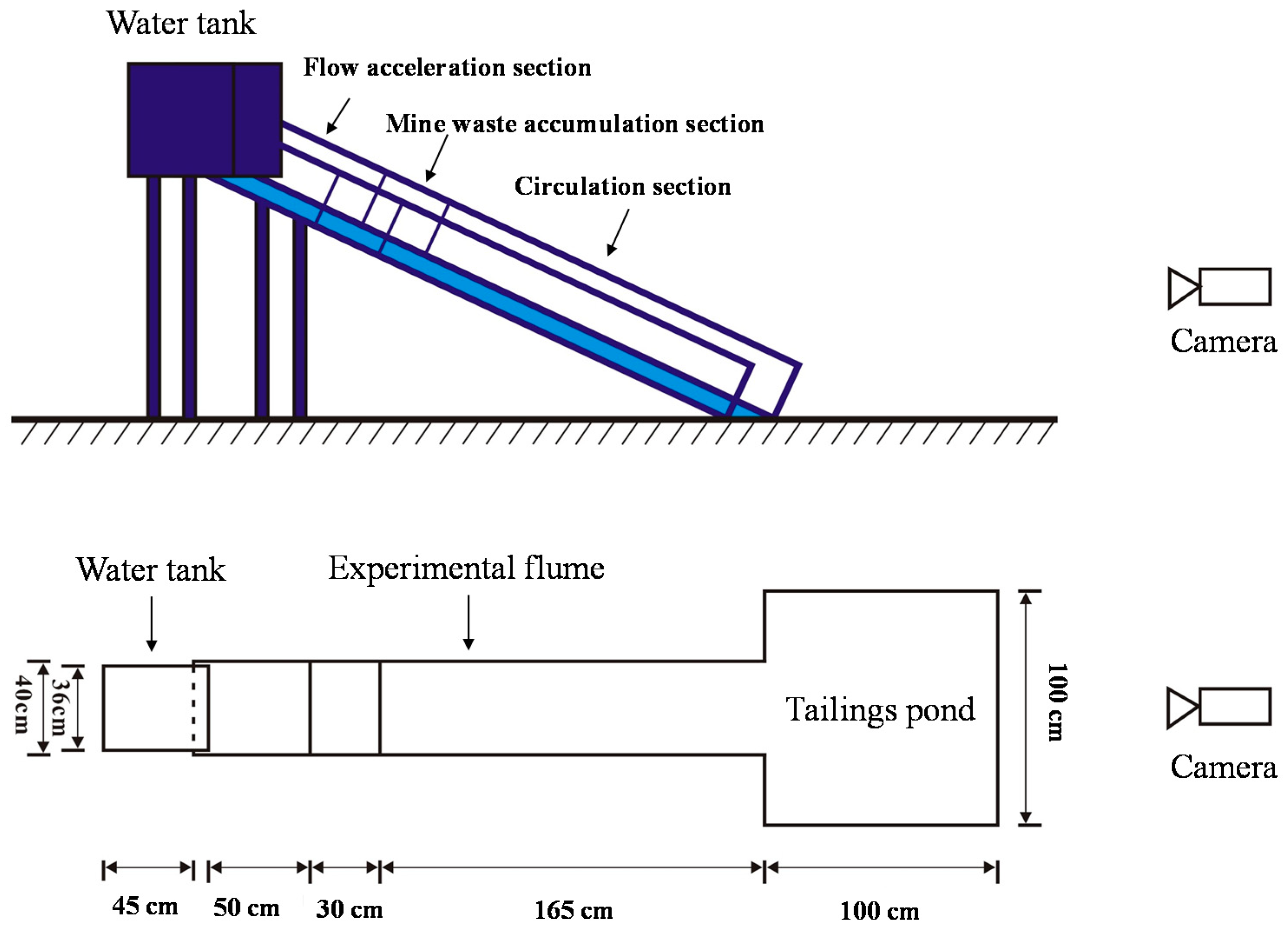

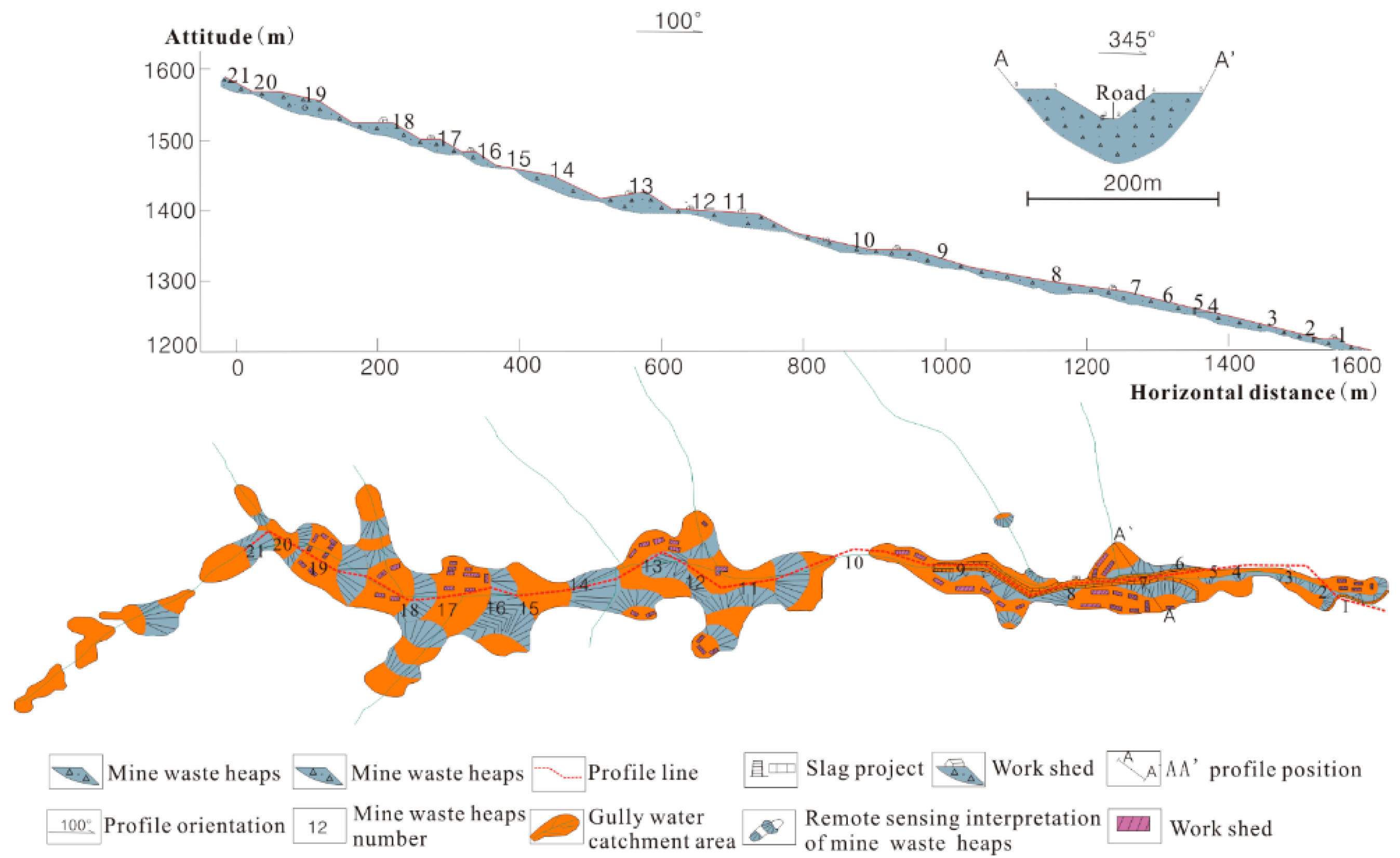

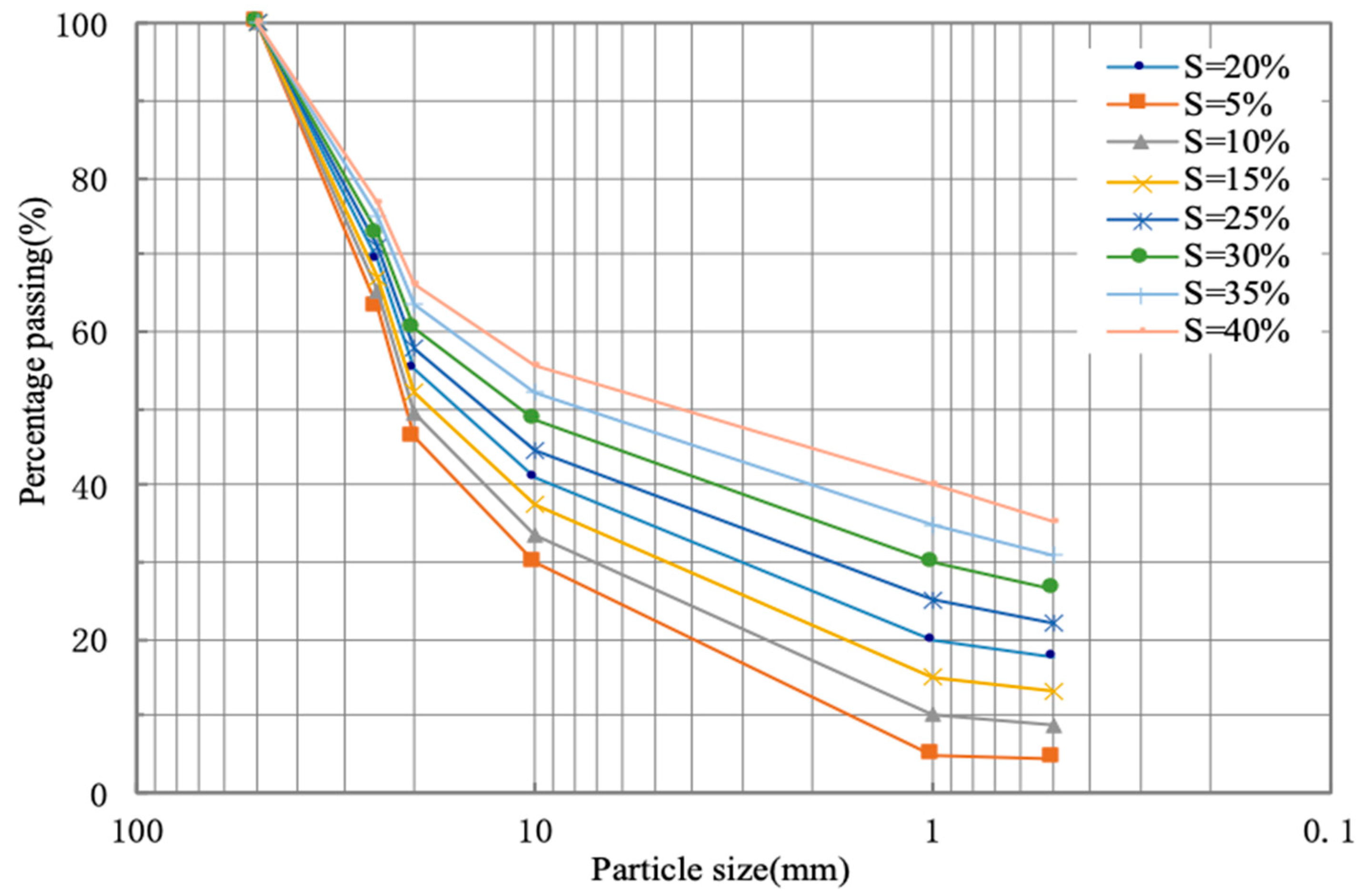



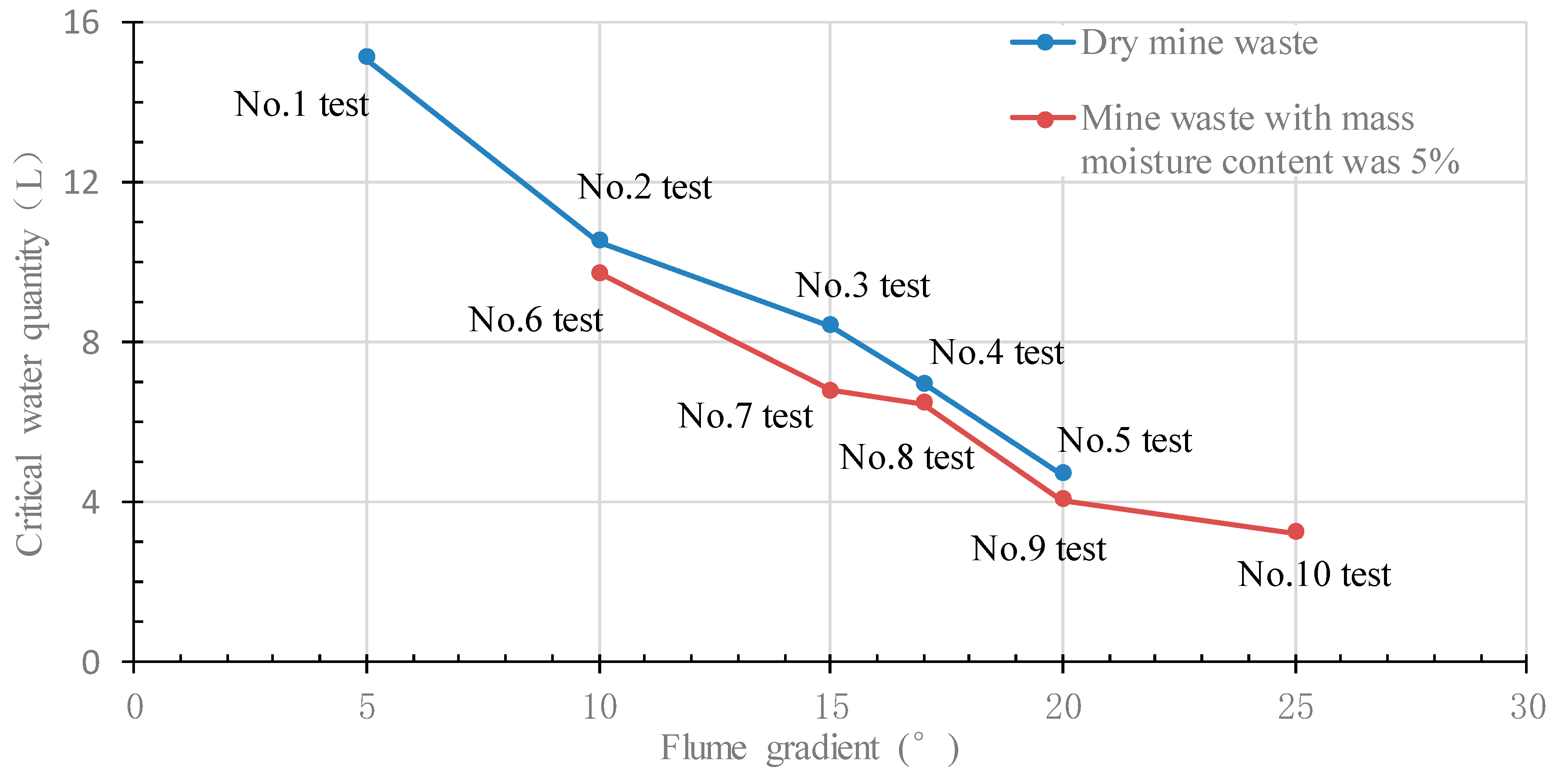
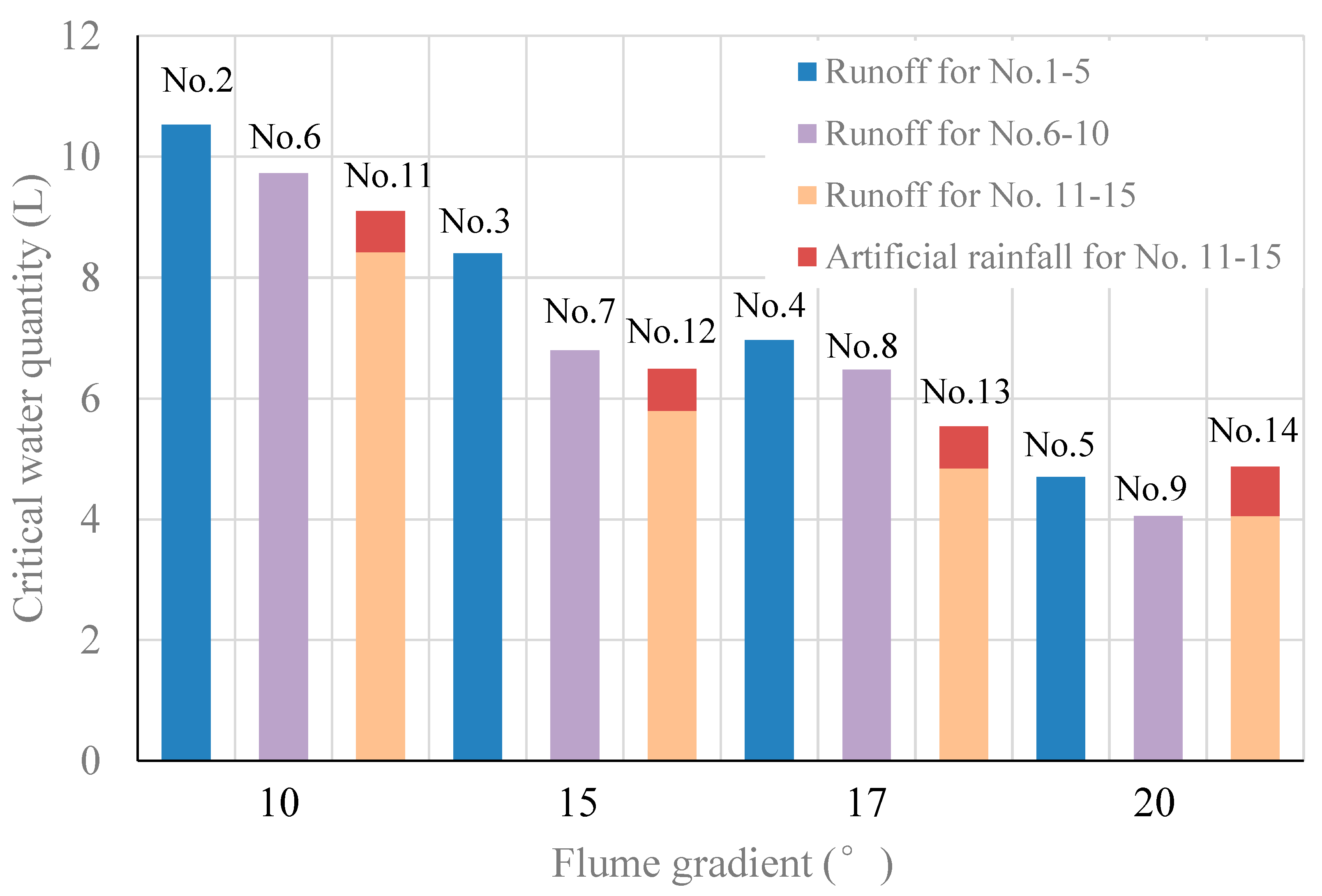
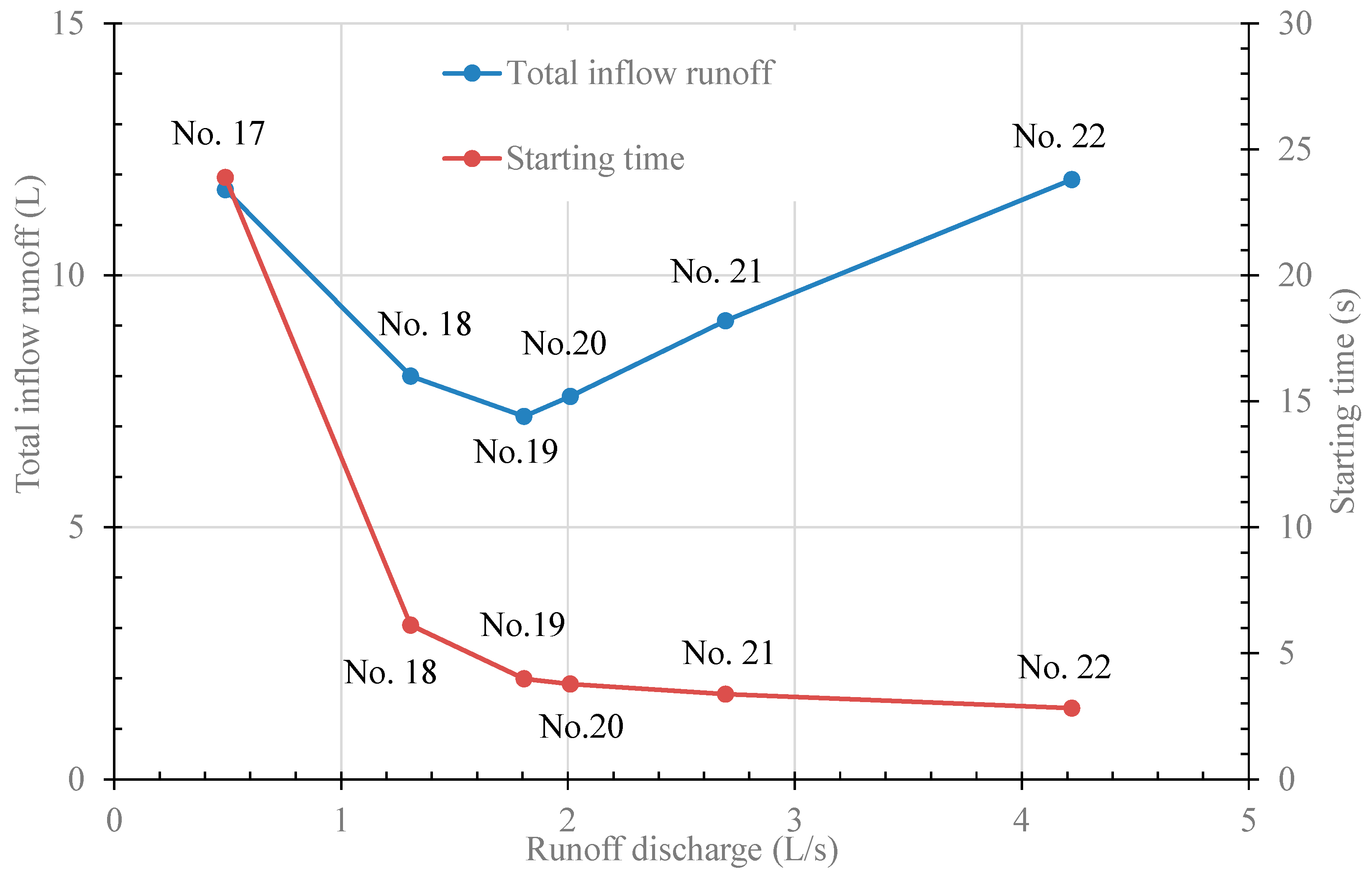
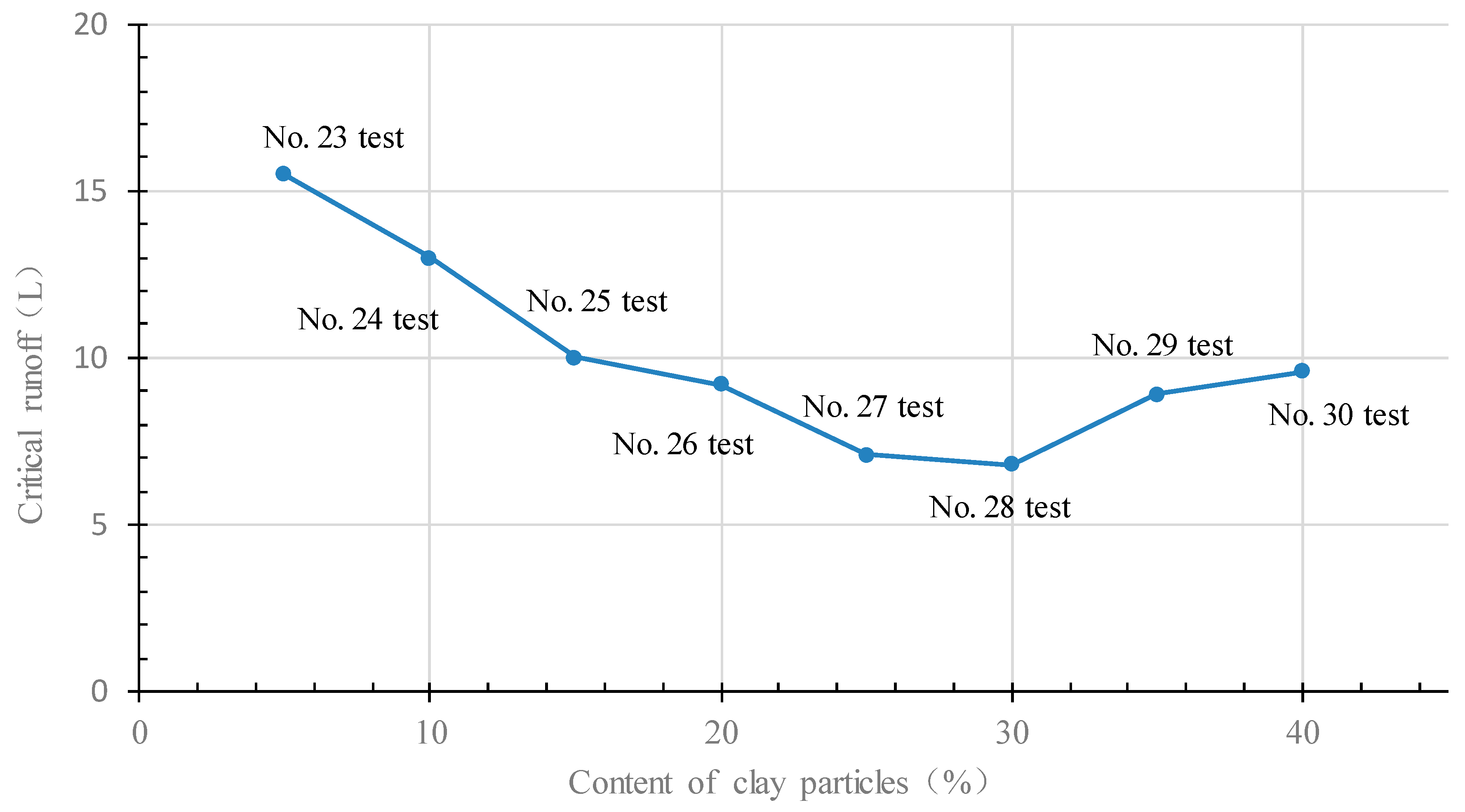
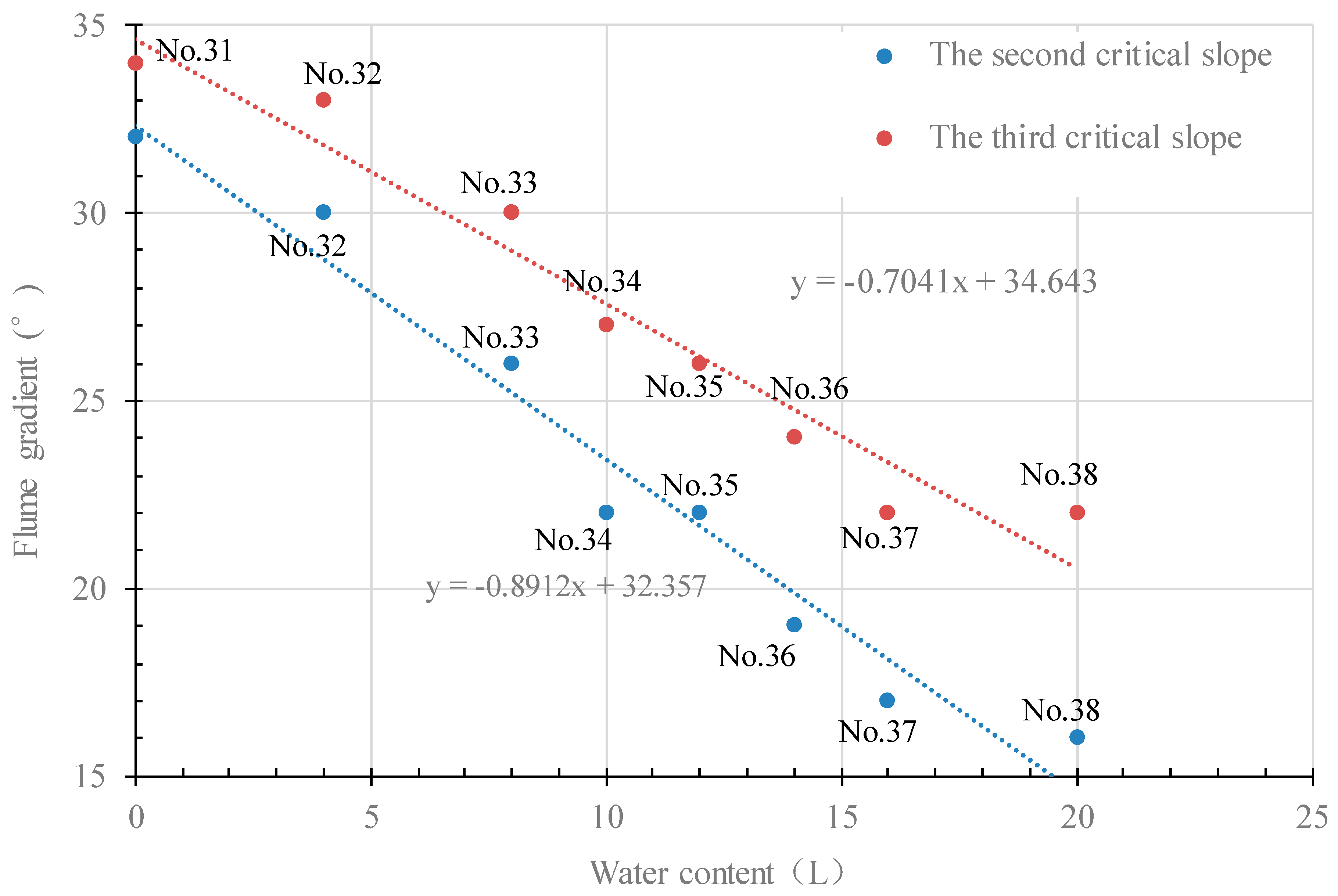


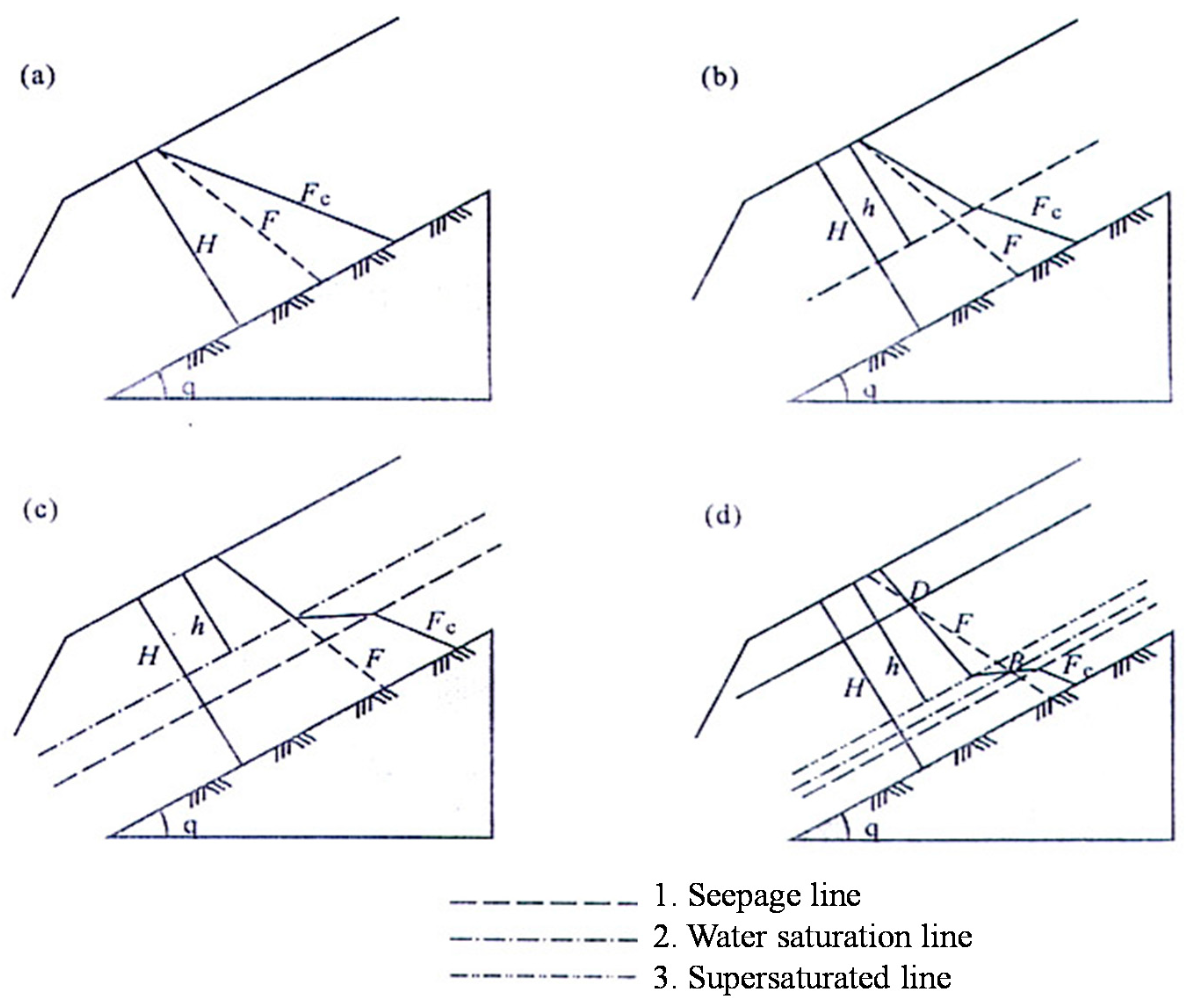
| No | Dry Density | Initial Water Content | Flume Gradient | Clay Particles Content | Inflow Discharge | Total Volume of the Upstream Runoff | Total Volume of the Artificial Rainfall |
|---|---|---|---|---|---|---|---|
| ρS (g/cm3) | w (%) | θ (°) | S (%) | Q0 (L/s) | Vi (L) | Vr (L) | |
| 1 | 1.94 | 0 | 5 | 20 | 1.9 | 15.1 | 0 |
| 2 | 1.94 | 0 | 10 | 20 | 1.9 | 10.53 | 0 |
| 3 | 1.94 | 0 | 15 | 20 | 1.9 | 8.4 | 0 |
| 4 | 1.94 | 0 | 17 | 20 | 1.9 | 6.97 | 0 |
| 5 | 1.94 | 0 | 20 | 20 | 1.9 | 4.7 | 0 |
| 6 | 1.94 | 5 | 10 | 20 | 1.9 | 9.72 | 0 |
| 7 | 1.94 | 5 | 15 | 20 | 1.9 | 6.8 | 0 |
| 8 | 1.94 | 5 | 17 | 20 | 1.9 | 6.48 | 0 |
| 9 | 1.94 | 5 | 20 | 20 | 1.9 | 4.05 | 0 |
| 10 | 1.94 | 5 | 25 | 20 | 1.9 | 3.24 | 0 |
| 11 | 1.94 | 0 | 10 | 20 | 1.9 | 8.42 | 0.68 |
| 12 | 1.94 | 0 | 15 | 20 | 1.9 | 5.8 | 0.69 |
| 13 | 1.94 | 0 | 17 | 20 | 1.9 | 4.84 | 0.7 |
| 14 | 1.94 | 0 | 20 | 20 | 1.9 | 4.05 | 0.82 |
| 15 | 1.94 | 0 | 25 | 20 | 1.9 | 3.04 | 1.28 |
| 16 | 1.94 | 0 | 17 | 20 | 0.08 | stable | 0 |
| 17 | 1.94 | 0 | 17 | 20 | 0.5 | 11.7 | 0 |
| 18 | 1.94 | 0 | 17 | 20 | 1.3 | 8 | 0 |
| 19 | 1.94 | 0 | 17 | 20 | 1.8 | 7.2 | 0 |
| 20 | 1.94 | 0 | 17 | 20 | 2 | 7.6 | 0 |
| 21 | 1.94 | 0 | 17 | 20 | 2.7 | 9.1 | 0 |
| 22 | 1.94 | 0 | 17 | 20 | 4.2 | 11.9 | 0 |
| 23 | 1.72 | 0 | 17 | 5 | 0.6 | 15.5 | 0 |
| 24 | 1.85 | 0 | 17 | 10 | 0.6 | 13 | 0 |
| 25 | 1.85 | 0 | 17 | 15 | 0.6 | 10 | 0 |
| 26 | 1.94 | 0 | 17 | 20 | 0.6 | 9.2 | 0 |
| 27 | 1.94 | 0 | 17 | 25 | 0.6 | 7.1 | 0 |
| 28 | 2.00 | 0 | 17 | 30 | 0.6 | 6.8 | 0 |
| 29 | 2.08 | 0 | 17 | 35 | 0.6 | 8.9 | 0 |
| 30 | 2.12 | 0 | 17 | 40 | 0.6 | 9.6 | 0 |
| No | Mine Waste Dry Density | Clay Particles Content | Water Content | Critical Slope | |
|---|---|---|---|---|---|
| ρS (g/cm3) | S (%) | w (%) | θ2 (°) | θ3 (°) | |
| 31 | 1.94 | 20 | 0 | 32 | 34 |
| 32 | 1.94 | 20 | 4 | 30 | 33 |
| 33 | 1.94 | 20 | 8 | 26 | 30 |
| 34 | 1.94 | 20 | 10 | 22 | 27 |
| 35 | 1.94 | 20 | 12 | 22 | 26 |
| 36 | 1.94 | 20 | 14 | 19 | 24 |
| 37 | 1.94 | 20 | 16 | 17 | 22 |
| 38 | 1.94 | 20 | 20 | 16 | 22 |
| 39 | 1.72 | 5 | 3 | 30 | 38 |
| 40 | 1.85 | 10 | 6 | 26 | 32 |
| 41 | 1.9 | 15 | 9 | 23 | 35 |
| 42 | 1.94 | 20 | 12 | 24 | 30 |
| 43 | 1.97 | 25 | 15 | 21 | 31 |
| 44 | 2 | 30 | 18 | 20 | 30 |
| 45 | 2.08 | 35 | 21 | 20 | 40 |
| 46 | 2.12 | 40 | 24 | 25 | 37 |
© 2020 by the authors. Licensee MDPI, Basel, Switzerland. This article is an open access article distributed under the terms and conditions of the Creative Commons Attribution (CC BY) license (http://creativecommons.org/licenses/by/4.0/).
Share and Cite
Cao, Y.; Zhu, X.; Liu, B.; Nan, Y. A Qualitative Study of the Critical Conditions for the Initiation of Mine Waste Debris Flows. Water 2020, 12, 1536. https://doi.org/10.3390/w12061536
Cao Y, Zhu X, Liu B, Nan Y. A Qualitative Study of the Critical Conditions for the Initiation of Mine Waste Debris Flows. Water. 2020; 12(6):1536. https://doi.org/10.3390/w12061536
Chicago/Turabian StyleCao, Yanbo, Xinghua Zhu, Bangxiao Liu, and Yalin Nan. 2020. "A Qualitative Study of the Critical Conditions for the Initiation of Mine Waste Debris Flows" Water 12, no. 6: 1536. https://doi.org/10.3390/w12061536






